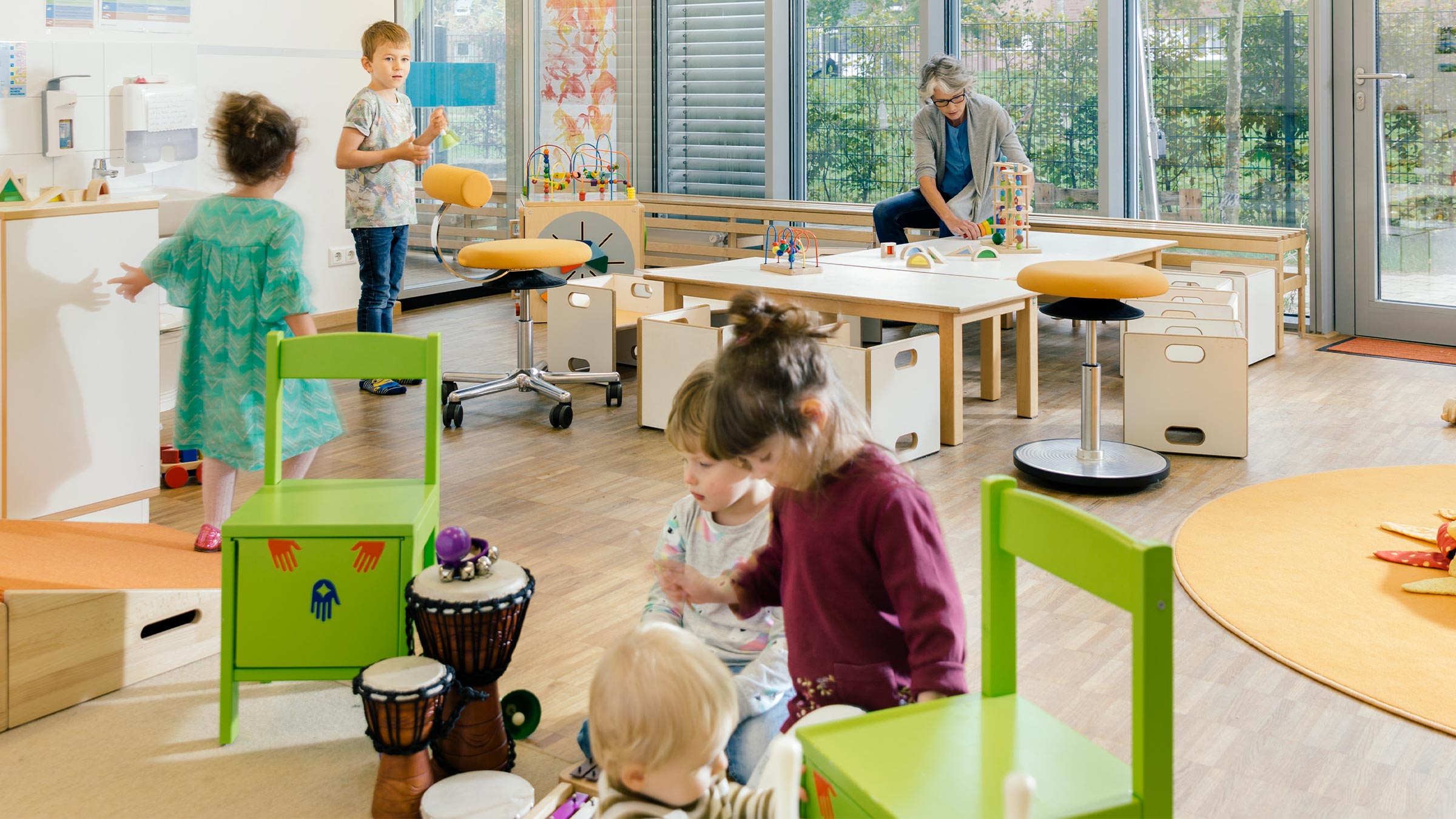On the surface, it seemed like the child care center in southwest Minnesota was doing very well. Enrollment had grown consistently, and the center was close to its licensed capacity. There were few indicators of financial stress, such as not having enough cash to pay expenses or having to dip into emergency funds.
Yet the manager said she was deeply concerned about its future, according to a survey conducted by the Minneapolis Fed and First Children’s Finance.
Expenses have increased significantly because of high inflation and higher wages needed in a tight labor market, the manager explained. Tuition hikes and pandemic-related state grants have offset expenses, but the grants expire this summer, and tuition hikes needed to bridge the gap would make care unaffordable for her families.
“Once the stabilization grants stop what will happen? Will we be able to stay open and afford our staff and be able to take the best care of our children?” the manager said.
The Minnesota survey, conducted in March, revealed fewer child care providers reporting indicators of financial stress than in the spring 2022 survey. Occupancy and enrollment are stable or growing for most providers. Yet, many are reporting changes in the child care market, both on the expense and the revenue sides, that threaten to upend their business model. Like the manager at the southwest child care center, many respondents reported that they depend on state grants to remain open.
Affordable child care is a critical part of the economy because it enables parents to hold jobs, according to Suzanne Pearl, Minnesota director for First Children’s Finance. “If the child care sector fails, the rest of the economy follows,” she said at a recent webinar discussing survey findings. “Ask any employer across Minnesota about what keeps them up at night and you are likely to hear that lack of available child care is a major barrier to their continued viability.”
More than 1,000 owners and managers of child care businesses and organizations responded to the survey, amounting to 13 percent of the state’s licensed providers (not including types of providers not covered by the survey). While the survey was not designed to necessarily represent the sector as a whole, the breakdown of respondents by type of license and by region is similar to that of the sector.
Encouraging signs for a discouraged sector
The child care sector has struggled for years, with the number of licensed providers falling each year and the number of licensed child care slots as a measure of capacity trending downward (Figure 1). As of March, the number of active licenses was down 33 percent compared to a decade ago and capacity was down 5 percent.
All of the declines have been with small, usually home-based providers, licensed as family child care (FCC) providers by state regulators. Providers licensed as child care centers (CCC), which are larger and typically located in commercial spaces, have increased in numbers and capacity but not enough to make up for the loss of FCC providers.
Since the pandemic began, and especially in the last couple of years, the decline of FCC providers has accelerated while the growth in CCC providers has slowed.
The survey, which provides some encouraging signs for the sector, must be viewed against this backdrop of declining numbers.
Among encouraging signs is the relatively small number of financial-stress indicators reported by providers. The median number of indicators for all respondents was 1.5, the same as in 2022. FCC providers, the group that has struggled the most over the years, reported a decrease from two indicators to 1.5. The indicators are based on answers to seven questions related to the financial health of child care businesses and their owners. Respondents were recorded as having one indicator for each question they answered that suggested poor financial health. For example, if they were asked about being able to pay rent or mortgage on time and they said “no,” that would be recorded as one indicator. Some survey questions allowed respondents to provide an in-between answer, such as only being able to pay interest on their mortgage. This would be recorded as 0.5 indicators.
At the same time, the share of respondents reporting more than three indicators as well as those reporting more than one indicator decreased for both FCC providers and CCC providers (Figure 2), which suggests that fewer providers experienced financial stress.
FCC providers were still more likely to report signs of financial stress than CCC providers (Figure 3) but they did show slight improvement compared with 2022. CCC providers improved with some indicators and worsened with others.
For example, the share of respondents who reported being unable to pay their mortgage or rent on time decreased from 17 to 12 percent among FCC providers. Among CCC providers, it increased from 13 to 20 percent.
The share of respondents who reported that losses from their child care business had affected their household income decreased from 71 to 57 percent among FCC providers and from 38 to 35 percent among CCC providers.
When respondents were asked how long they expected to remain in business, the share of FCC providers who said less than a year decreased from 20 percent to 18 percent, but CCC providers remained unchanged at 19 percent. The share of those who simply didn’t know how long they could endure grew for both, from 49 to 52 percent for FCC providers and from 54 to 58 percent for CCC providers.
That a fifth of providers could close within a year and half of them could close at any time shows “a concerning level of insecurity,” Pearl said.
While the indicators together show that FCC providers are healthier financially than a year ago, they may understate the struggle for many. Because of the way they operate, FCC providers are able to absorb or avoid blows that CCC providers often can’t. For example, many FCC owners operate out of their own homes and don’t have to contend with increasing rent. At many FCC providers, the owner is the only employee, which means they have not had to compete for workers like CCC providers. Yet many FCC owners also report paying themselves very low wages and being unable to afford benefits.
“I relied on my husband’s paycheck to cover bills because mine barely covers business expenses,” said the owner of a west central FCC business with 0.5 financial stress indicators. “We certainly don’t do this for the money. We love kids and our daycare families are an extension of our own.”
Another encouraging sign for child care providers is the relatively high occupancy that many enjoy. The median for CCC providers grew from 88 percent to 91 percent and, for FCC providers, it remained at 90 percent. The sector considers occupancy of 85 percent to be healthy for providers, leaving some flexibility for turnover. Most providers reported neutral to positive enrollment trends with 45 percent saying theirs didn’t change and 21 percent reporting it increased.
But the occupancy mentioned above is based on available staff. Sixty-three percent of CCC providers and 4 percent of FCC providers indicated they are licensed to care for more children but are unable to do so for lack of staff. This is especially so in the seven-county Twin Cities region, where a greater share of both kinds—71 percent of CCC providers and 6 percent of FCC providers—said they could increase enrollment with more staff.
Pearl said the Twin Cities could be more challenging for providers competing for workers because there are more opportunities for higher-paying jobs there than in Greater Minnesota.
Among those that were understaffed, the potential enrollment increase could be significant with the median increase of 27 percent for both CCC and FCC providers.
Business model in flux
The problem is the business model for providers is shifting, based on respondents’ comments.
On the revenue side, demand is growing for infant and toddler care but not for care of preschool and school-age children. Typically, young children are loss leaders for providers who earn their profits from caring for older children. The staff-to-child ratio required by state regulators makes young children more labor intensive; CCC providers, for example, must have 1 staff member for every 4 infants compared to 1 for every 10 preschoolers, who are 33 months to 5 years old.
As a result, the true cost of caring for infants is more than most families can afford. Providers enroll infants and charge below cost either because they expect to care for the infants when the infants are older and more profitable or because infants have older siblings requiring care.
Many providers say public schools are undermining this business model by providing programs for 3- to 4-year-olds at low cost or, for at-risk children, no cost. Some schools provide low-cost after school activities as well.
“I know I’m not the only one who has suffered severely,” the owner of a Twin Cities CCC business said of these programs. “It took so much income from the centers, especially the small centers, since preschool was where we made the extra money to keep the infant and baby rooms running.”
But parents working from home or hybrid hours are also disrupting the child care business, providers say. According to the state Department of Employment and Economic Development citing census data, nearly a quarter of Minnesota workers worked from home this past February.
“This is my youngest group ever,” said the owner of a central Minnesota FCC business. “I usually have a good mix of ages, including five school-age [children]. That’s no longer the case. The face of work has changed. Parents still need care but mostly only for the very young.”
On the expense side, respondents said they experienced the pain of inflation, especially with food and energy (Figure 4), just as other businesses have. Food can be an especially significant share of total costs amounting to 26 percent of an FCC provider's expenses, according to a pre-pandemic estimate. Wages are also going up as employers struggle with a tight labor market. Providers say they have never been able to pay their teachers very much but now retailers and fast-food chains have surpassed them in wages.
“Target, Culver’s, and McDonald’s have higher starting wages, and we require college level training,” said the manager of a child care center in southeast Minnesota. “It is clear that people will not want to be childcare staff without benefits or livable wages.”
Sixty-one percent of CCC respondents said they found hiring very difficult despite most offering higher pay and other incentives. That’s a significant number but actually an improvement over a year ago when 73 percent said hiring was very difficult. Those rates were lower for FCC providers, many of which are either staffed by just the owner or by the owner’s family members.
The higher expenses have forced providers to increase tuition despite the reluctance of many, especially FCC owners, to do so for fear of making care unaffordable for families already struggling with inflation. Sixty seven percent of CCC respondents and 36 percent of FCC respondents had increased tuition over the past year. A year ago, those figures were just 56 percent and 20 percent, respectively.
“We’ve seen child care providers across the sector basically eating their losses by not paying themselves or forgoing needed facility repair or cutting back on program activities, curriculum for their kids,” Pearl said. “But there’s only so long that any business can survive that way.”
These challenges are not new. Respondents to the 2022 survey mentioned them, too. But the declining number of providers means that those challenges remain as relevant as ever despite some encouraging signs.
Many changes to providers’ business models came at the same time as the pandemic, during which the federal government provided significant funding, some administered by state and local governments, to assist small businesses. In Minnesota, one of the most common forms of assistance for child care providers is the Child Care Stabilization Base Grant with 90 percent of respondents saying they had received it. It’s meant to help providers keep their staff employed and many said they had used the grant to offer pay hikes or bonuses.
For FCC providers, the money has helped many owners pay themselves more than they could otherwise. For CCC providers, it allowed them to remain viable. If they couldn’t maintain staff size, they wouldn’t be able to meet the state mandated staff-to-child ratios, and would have to reduce enrollment.
The owner of a Twin Cities CCC business said that even with the stabilization grant helping her pay her staff, it’s been so difficult to hire that the business is losing money from excessive overtime pay. She said without the grants her wages will be much less competitive, and she could be out of business in four to six months.
The stabilization base grant has now been cut in half and will expire at the end of June, according to Pearl. As of early May, Minnesota lawmakers are working on a replacement grant, among other efforts to help the child care sector, but it’s not a sure thing.
Providers struggling to make ends meet
While the survey does not ask providers about their profit margins, it’s clear from their comments that profits for most are thin and becoming thinner. In fact, 25 percent of FCC owners and 19 percent of CCC owners said they had been unable to pay themselves at times.
Some providers reported making drastic cuts to personal spending to survive. For example, one Twin Cities FCC owner moved into the space in her home that she had used just for child care—meaning the space is now both her business and her dwelling—and rented out the space that she used to live in. She reported reducing every expense “as far as possible,” with no cable TV, no new clothes, no vacations, and no professional haircuts; she now cuts it herself.
Others said they relied on their spouses to subsidize their business.
The owner of a northwest Minnesota FCC said she was only able to pay her business expenses because of her husband’s job. “My business has showed a loss the last two years of being open. We could not survive without his income and my second job.”
For some, it was time to quit the business they love.
Despite having her husband’s job to help out with family expenses, the owner of a Twin Cities FCC business who had been open for more than a decade complained that they live “at least three paychecks behind” and struggle to pay for basic needs. “I’m currently looking for a job outside of child care and will close my business permanently when I find one.”
Tu-Uyen Tran is the senior writer in the Minneapolis Fed’s Public Affairs department. He specializes in deeply reported, data-driven articles. Before joining the Bank in 2018, Tu-Uyen was an editor and reporter in Fargo, Grand Forks, and Seattle.






